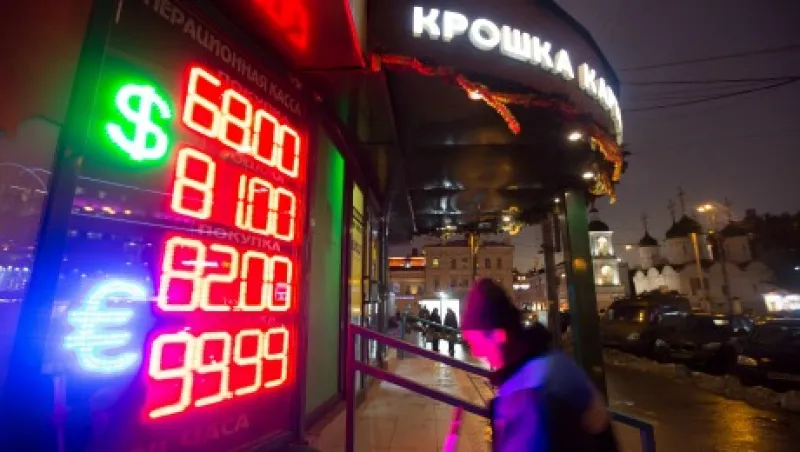As investors prepare for a trading week in much of the world shortened by holidays, Russia returns to the forefront of market risk narratives. The ruble staged a modest rebound versus the U.S. dollar and euro over the weekend as the Kremlin continues to scramble to limit the impact of the currency’s plunge and Western sanctions. The Central Bank of Russia today announced a 30 billion ruble ($530 million) facility to prop up Trust Bank, the first bailout since last week’s passing of legislation to make funds available to prop up failing financial-sector firms. The bank will now be operated under the oversight of Russia’s Deposit Insurance Agency. Meanwhile, as price inflation rises in the politically sensitive food segment, President Vladimir Putin’s government continues to take actions, including an expansion on wheat export controls last week. Separately, in an interview with Thai media outlets over the weekend, China’s Foreign minister Wang Yi and Commerce minister Gao Hucheng pledged support for Russia, including a possible expansion of the existing currency swap between the nations announced in October. The question facing both investors and the citizens of Russia now is whether any of these actions will restore confidence in the ruble or if it will continue a downward spiral until an agreement is reached with the West.
Bulls returning to oil. West Texas Intermediate crude oil futures rose in electronic trading sessions over the weekend as fighting in a western region of Libya that includes the port of Mellitah has led to suspended shipments and production shutdowns. Commodity Futures Trading Commission commitment of traders data released last week revealed a 14 percent increase over the prior week in net-long commitments in the WTI market by investors in futures.
U.S. home sales data on deck. Existing home sales for November will be released today with consensus forecasts for a seasonally adjusted slowdown for the month that will bring the annual pace to 5.2 million. October registered a softer expansion that September, when the overall pace of sales rose by a 2.6 percent for the month.
Greek elections go into next round. The second round of national elections in Greece, to be held tomorrow, is not expected to result in a definitive victory for any group, necessitating a third round on December 29. Prime Minister Antonis Samaras surprised the parliament on Sunday, offering a compromise of an early election in 2015 in exchange for backing of his government’s preferred candidate Stavros Dimas. The move was perceived by political analysts as a signal of how concerned the current government is over gains by antiausterity parties, such as the main opposition party Syriza.
Portfolio Perspective: Oil Inventory Building Continues, Product Stocks Next — Michael Cohen, Barclays
Latest stock data from the International Energy Agency show OECD oil inventories building counter seasonally in October, by 1.4 million barrels, compared to the 31 million-barrel average draw over the past three years. In our view at Barclays, the trend of inventory builds is set to continue, as reflected in our oil market balances. We expect the market imbalance that has materialized in recent months to reach a high point during the first half of 2015. Our forecast indicates that at that time the call on OPEC should average 28.6 million barrels per day. With OPEC having stated its commitment to let the market balance naturally, market consensus is that the organization will continue to produce at or above its 30 million-barrel-per-day mandate — assuming no supply disruptions, no emergency cuts and no voluntary individual cuts). As a result, the market should experience a period of significant stock building, particularly during the first six months of the coming year, when the balances look the weakest.
Beyond commercial storage, China and India are filling strategic oil stockpiles, which should result in a strong prompt reduction in supplies. China has been active in the market this year and has further room to fill its storage capacity. Of its 343 million-barrel commercial capacity, 20 percent is left to fill, as is another 64.1 million barrels in strategic petroleum reserve (SPR) site capacity planned for completion next year. Once this is filled, it would top off China’s Phase 2 Strategic Petroleum Reserve at a total of 244.8 million barrels. India is looking to build up 38.9 million barrels of SPR next year. On average, if that quantity were filled in the coming year, it would add 470,000 barrels per day to crude demand.
The next phase in inventory building is on the refined products sector, in our view. Over the course of the coming weeks, we expect the physical crude oil markets to see refineries actively bidding for crude as their margins improve on lower crude feedstock. Opportunities to store crude offshore also should emerge. But this is likely to result only in crude conversion to refined product stocks, given that end-user demand is still not enough to absorb all the throughput. Once these product stocks get built, refinery margins will come under pressure, prompting refineries to be less active in bidding crude, which could lead to lower oil prices than even present levels over the first quarter.
Michael Cohen is head of energy markets research for Barclays in New York.






